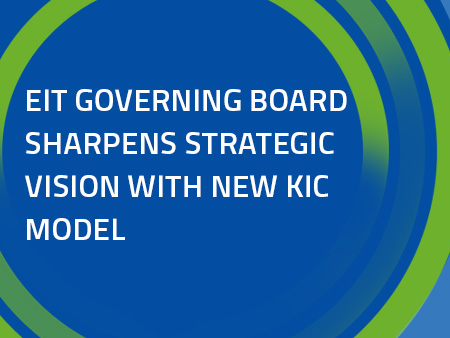EIT Governing Board Sharpens Strategic Vision with New KIC Model and Proposals to Strengthen EU Innovation Ecosystem

The European Institute of Innovation and Technology (EIT) Governing Board has released its updated vision outlining concrete steps to boost Europe’s competitiveness through innovation in the next EU long-term budget (Multiannual Financial Framework) running from 2028 to 2034.
At the heart of the EIT model is a unique ecosystem approach that brings together business, education, and research to power collaborative innovation across Europe. A key highlight of the updated vision is the proposed Knowledge and Innovation Community (KIC) Model, which sets out seven principles for high-performing KICs, including streamlined governance and operations, stronger industry leadership, and financial sustainability from the outset.
With this updated vision, we reaffirm the EIT’s unique role in fostering collaboration in innovation across Europe. The new KIC Model is built on 15 years of experience, showing that focused, agile, and industry-engaged partnerships are key to delivering impact. We are ready to work with all partners to ensure that innovation drives Europe’s competitiveness and reaches every region
Stefan Dobrev, Chair of the EIT Governing Board
The EIT is the EU’s key instrument for putting the knowledge triangle – higher education, research and innovation, and business – into practice to turn ideas into innovation. The Governing Board proposes a set of reforms to strengthen the EIT’s role as a pan-European ecosystem facilitator and better guide innovators to the right EU support. It also proposes ways to improve how different EU innovation tools work together:
- a common innovation framework connecting EU instruments from idea to scale-up;
- simplified and harmonised processes to ease access for innovators;
- stronger synergies in talent development, policy implementation and investment.
The updated Vision reaffirms the two strategic objectives at the core of the EIT’s future role: (1) closing the innovation gap across Europe – particularly in widening countries through initiatives like the EIT Regional Innovation Booster – and (2) closing the skills gap to deliver the talent needed for Europe’s competitiveness.
The vision proposes to position the EIT AS a key enabler for key priorities of the European Commission such as the recently adopted Union of Skills and the Startup and Scaleup Strategy, and supports the Clean Industrial Deal through enhanced innovation and skills development.
In response to areas with high future innovation potential, the EIT proposes security and resilience as well as AI and Robotics as two potential themes for future KICs, among others. This reflects the EU’s strategic priorities for security and technological leadership as described in the Competitiveness Compass.
The vision reaffirms the EIT as a strategic partner to the European Innovation Council (EIC), leveraging its broad network to channel early-stage ventures into the innovation pipeline, extending the reach of EU tools into underrepresented regions, and equipping innovators with the skills and industrial connections needed for scaling.
These proposals position the EIT – thanks to its unique mix of partnerships, expertise, and shared funding – as a key driver of EU competitiveness and a force for a more connected, inclusive, and results-focused European innovation landscape. Since 2008, the EIT has supported over 9,900 companies, powered the launch of more than 2,400 new products and services, and helped raise nearly €10 billion in external funding. Its education initiatives have trained over 1.3 million learners in innovation, entrepreneurship, and deep tech across Europe.


 Share this page
Share this page


